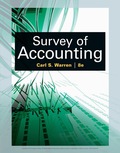
Concept explainers
On January 24, 20Y8, Niche Consulting collected
$5,700 it had hilled its clients for services rendered on December 31, 20Y7. How would you record the January 24 transaction, using the accrual basis?
A. Increase Cash, $5,700; decrease Fees Earned, $5,700
B. Increase
C. Increase Cash, $5,700; decrease Accounts Receivable, $5,700
D. Increase Cash, $5,700; increase Fees Earned, $5,700
Want to see the full answer?
Check out a sample textbook solution
Chapter 3 Solutions
Survey of Accounting (Accounting I)
Additional Business Textbook Solutions
Horngren's Accounting (12th Edition)
Financial Accounting, Student Value Edition (5th Edition)
Horngren's Cost Accounting: A Managerial Emphasis (16th Edition)
Marketing: An Introduction (13th Edition)
Principles of Operations Management: Sustainability and Supply Chain Management (10th Edition)
Gitman: Principl Manageri Finance_15 (15th Edition) (What's New in Finance)
- Marquis Company estimates that annual manufacturing overhead costs will be $839,000. Estimated annual operating activity bases are direct labor cost $501,000, direct labor hours 52,000, and machine hours 101,000. Compute the predetermined overhead rate for each activity base. (Round answers to 2 decimal places, e.g. 10.50.)arrow_forwardProblem related general Accountingarrow_forwardProvide correct answer this financial accounting questionarrow_forward
 Survey of Accounting (Accounting I)AccountingISBN:9781305961883Author:Carl WarrenPublisher:Cengage LearningPrinciples of Accounting Volume 1AccountingISBN:9781947172685Author:OpenStaxPublisher:OpenStax College
Survey of Accounting (Accounting I)AccountingISBN:9781305961883Author:Carl WarrenPublisher:Cengage LearningPrinciples of Accounting Volume 1AccountingISBN:9781947172685Author:OpenStaxPublisher:OpenStax College Cornerstones of Financial AccountingAccountingISBN:9781337690881Author:Jay Rich, Jeff JonesPublisher:Cengage Learning
Cornerstones of Financial AccountingAccountingISBN:9781337690881Author:Jay Rich, Jeff JonesPublisher:Cengage Learning


